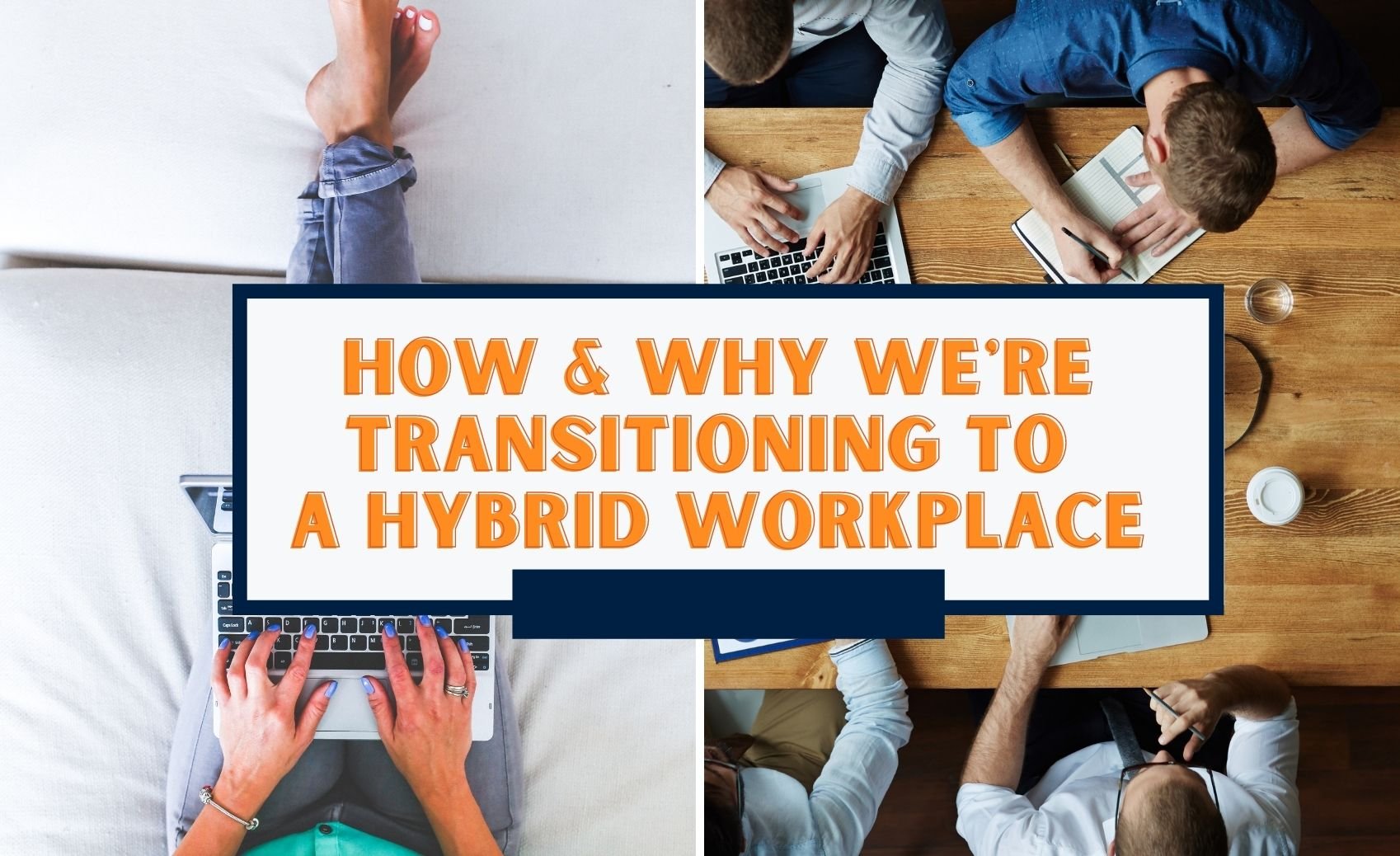How and Why We’re Transitioning to a Hybrid Workplace Post-Pandemic
Navigating the last year and a half as a small business has been like finding your way to the kitchen for a glass of water in a house you’ve never been in. In the middle of the night. Blindfolded. With legos all over the ground. And the furniture keeps moving around. The point is, it’s been difficult, to say the least. But, the last 18 months have also taught us so much about how to provide a positive, safe, and flexible work environment for our employees.
A large part of establishing and maintaining a stable environment during such an unstable time has been adapting to a remote workspace. We were among the millions of companies who were forced to transition our office to a fully remote setting because of COVID-19 in the spring of 2020. Now, almost a year and a half later, we are preparing to once again shift into a new stage of flexible working: a hybrid workplace.
What is a Hybrid Workplace?
Generally speaking, companies that have a hybrid workplace combine the benefits of office life with the flexibility of working from home.
Why We Chose a Hybrid Workplace Model
As the CDC began relaxing restrictions for vaccinated people, we were once again faced with a decision that needed to be made. We still had an office space from before the pandemic, so what would we do with it? Now that we had adjusted to a fully remote work style would we stay fully remote? Was it time to move back into the office full time? If so, how would that affect our employees’ productivity and lifestyles that they had adjusted to over the last year?
Last July, as the world was still trying to adjust to the ever-changing “new normal” we sent out a survey to our employees about remote work. We wanted to see how they were adjusting and what their thoughts were for the future of working remotely at Service Direct. At the time, 100% of employees surveyed said that they would be interested in working remotely at least part of the time in the future. Now, a year later, we sent out a similar survey to see if people’s thoughts and opinions on the matter have changed.
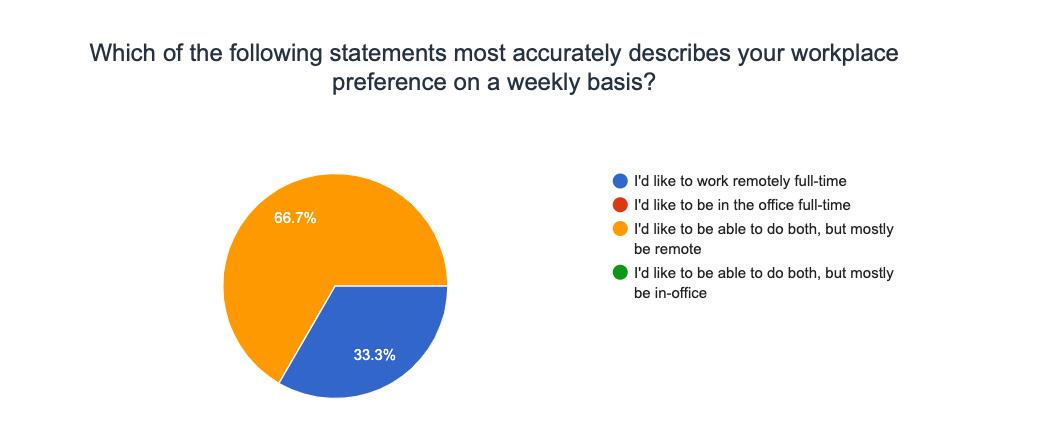
Based on the results of our recent survey, it’s clear that employees are still wanting to work remotely at least part of the time. The fact that 100% of employees who answered the survey want to work remotely at least part-time only reinforces our decision to transition to a hybrid workplace. Additionally, the majority of people surveyed said that they anticipate spending 25% or less of their time in the office. This is also in line with our hybrid workplace as it will allow us to use the office safely and not have to worry about high demand or over capacity.
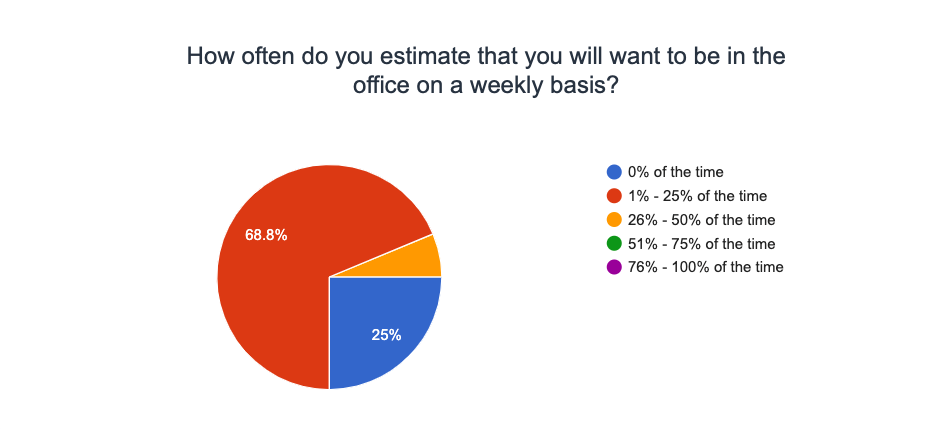
After looking at the opinions of our employees, we are confident that a hybrid workplace is going to be the most effective workplace policy for us moving forward. Those preferences combined with the undeniable benefits of hybrid offices make us not only optimistic that it is the right direction to go in, but they also make us excited to venture into this new chapter of our small business.
“When the pandemic shut everything down we were forced to go remote and adjust to the new work reality one day at a time,” said Brian Abernethy, CEO, and Co-Founder at Service Direct. “Initially I worried things would fall through the cracks and productivity would dip, but I was surprised to see an increase in the quality of work and communication throughout the company. It reinforced the idea that we can adapt and overcome anything as a company and there are still things out there that could further boost our productivity and work-life balance. We’re hoping a hybrid workplace is one of those things.”
Benefits of a Hybrid Workplace
-
Allows you to increase your hiring pool. By not requiring employees to work in person, companies are able to hire individuals from across the country. This brings the possibility for more qualified individuals and top talent to join your business.
-
Flexibility greatly benefits the mental health of your employees. By giving employees the option to work at the office or in their homes you are creating a workplace that promotes mental health. This can be especially beneficial for employees who are trying to take care of their mental health while traveling and changing locations frequently. Even before the pandemic, 97% of people felt that having a flexible work schedule could have a big impact on their mental health.
-
It is a huge perk for hiring new talent. Most business owners know that the best way to bring in the top talent is to offer top-tier benefits. And while it's never a bad idea to have a new hire welcome kit for new employees, in this new post-pandemic world, the greatest gift for new hires is a flexible remote work policy. In fact, only 3% of people surveyed said they want to return to an office full-time.
-
It can help keep overhead costs down while getting the benefits from in-office work. If you are an ever-growing company like ours, there’s a chance you may outgrow your office space. We did before the pandemic, which meant that in addition to our own office building, we had to rent office space so all of our employees could have a place to comfortably work. Now, with a hybrid workplace, we can revert back to our single-office setup and cut down on those costs while still providing an office for those employees who would like to come into the office.
-
The flexibility of a hybrid office promotes productivity for every employee. Some people are a heads-down-for-hours kind of worker while others may need to take a break every ten minutes to get good work done. Whatever your employee's workstyles are, a hybrid office allows them the flexibility to find the most productive workstyle for them. In other words, having the option of going into an office setting or staying home and working there affords people to choose what makes them feel the most productive.
-
Provides in-person availability for new hires. While having the option to work remotely is a huge draw for people, fully remote companies also have to navigate the difficult terrain of training new employees over video conferencing. With a hybrid workplace, you can bring new employees in for crucial one-on-one communication at the outset while still offering the remote perk after orientation.
How We’re Transitioning to a Hybrid Workplace
Once we decided that a hybrid office was the best option moving forward we had to discuss our strategy for transitioning into the new model. We are lucky to have just hired a new office manager, Sarah Reich, who will be an invaluable asset to adjusting back to the office. Sarah has experience working in a hybrid office and said that she is excited to be a part of Service Direct’s transition.
“I am appreciative to work for a company that genuinely values its employee’s perspectives and opinions regarding their individual health and wellness,” Sarah said. “A hybrid work model gives employees more freedom about when they can work and where they can work from.”
Keeping Safety a Top Priority
We’d be remiss if we didn’t acknowledge that society is not out of the woods yet with regard to the Coronavirus pandemic. As highly infectious strains like the Delta variant spread we have to remain diligent in prioritizing the safety of our employees. That means closely adhering to CDC guidelines and encouraging our employees to get vaccinated if they are able.
“We understand that even now we have to stay diligent on following what the CDC recommends for group gatherings and face coverings when transitioning to the hybrid office,” Brian said. “Ultimately the safety of our employees is our top priority, which means we as a company need to be flexible and communicate as much as possible.”
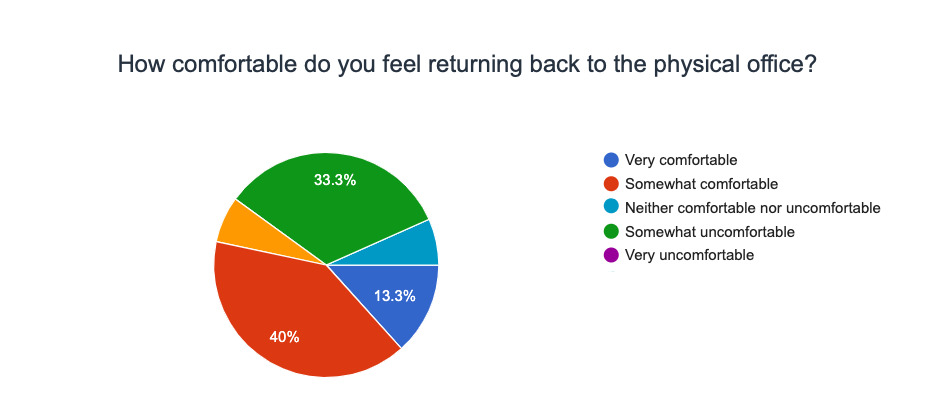
The leadership at Service Direct is dedicated to setting an example to the employees by getting vaccinated, which is still the best way to ensure you won’t be hospitalized if infected with COVID-19. By having hand sanitizing stations, limits on group numbers in the hybrid office, and encouraging our employees to get vaccinated, we are doing our best to limit the spread of the virus. We are putting the safety and comfort of our employees at the top of our priorities and no one will be asked to come into the office if they feel uncomfortable about potential exposure.
Developing a Hybrid Office Policy
It’s important at the outset of our hybrid workplace that we have policies in place not only so that the transition is smooth but also so we can use the office space as effectively as possible. But, as with any new venture, we understand that these policies will need to be malleable and they may not all remain applicable to our hybrid office in the long run. A few things we have decided to include in our initial hybrid workplace policy are:
- Make sure to reserve a desk if you plan on being in the office so we can know who will be there and when.
- There is no amount of required in-office time. Our employees may choose to stay fully remote if they would like.
- If you are located in Austin and are asked to be in the office for a meeting, you are expected to be in attendance.
- Communicate with Sarah, the office manager, if you want to be in the office outside of business hours (8 a.m. to 6 p.m.) so that she can ensure everything is set up for you.
The most important facet of our hybrid office policy is communication and flexibility. We expect employees at every level to communicate with others to the best of their ability so that people can plan accordingly. Additionally, we want to continue the level of flexibility that we have developed during our time working fully remote. If there is one thing we have learned over the last year and a half it’s that there is no such thing as too much communication and flexibility.
“I’ve had a good time figuring out the things that probably will work best but who knows? We’re going to have to take things a day at a time in the beginning,” John said. “I think I’m going to love having the ability to bring my team together or host meetings in person and work sessions in person, and then disperse to do our deep work and other places. All in all, it’s going to be incredibly good to be together again and be able to easily run ideas by each other as well as have camaraderie and to enjoy the energy that is working with other people.”
Using the Office Space Effectively
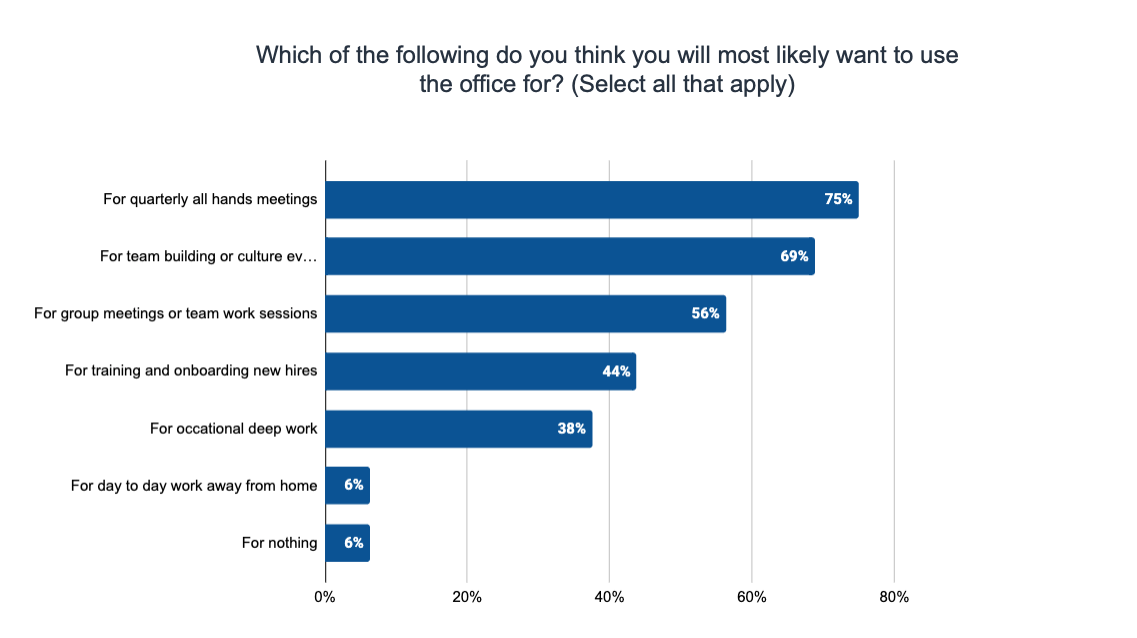
“The hybrid office is pretty much my dream situation. My role has been to listen to everybody’s feedback and try to work with the blank slate that is our office to understand how to rebuild it,” John, CTO and Service Direct Co-Founder, said. “Our goal is flexibility first and supporting people with doing all of the different types of work that they need to do. As long as we can communicate, schedule clearly, and not step on each other's toes when one team needs a resource and it’s unavailable to another, I think we’re going to be great.”
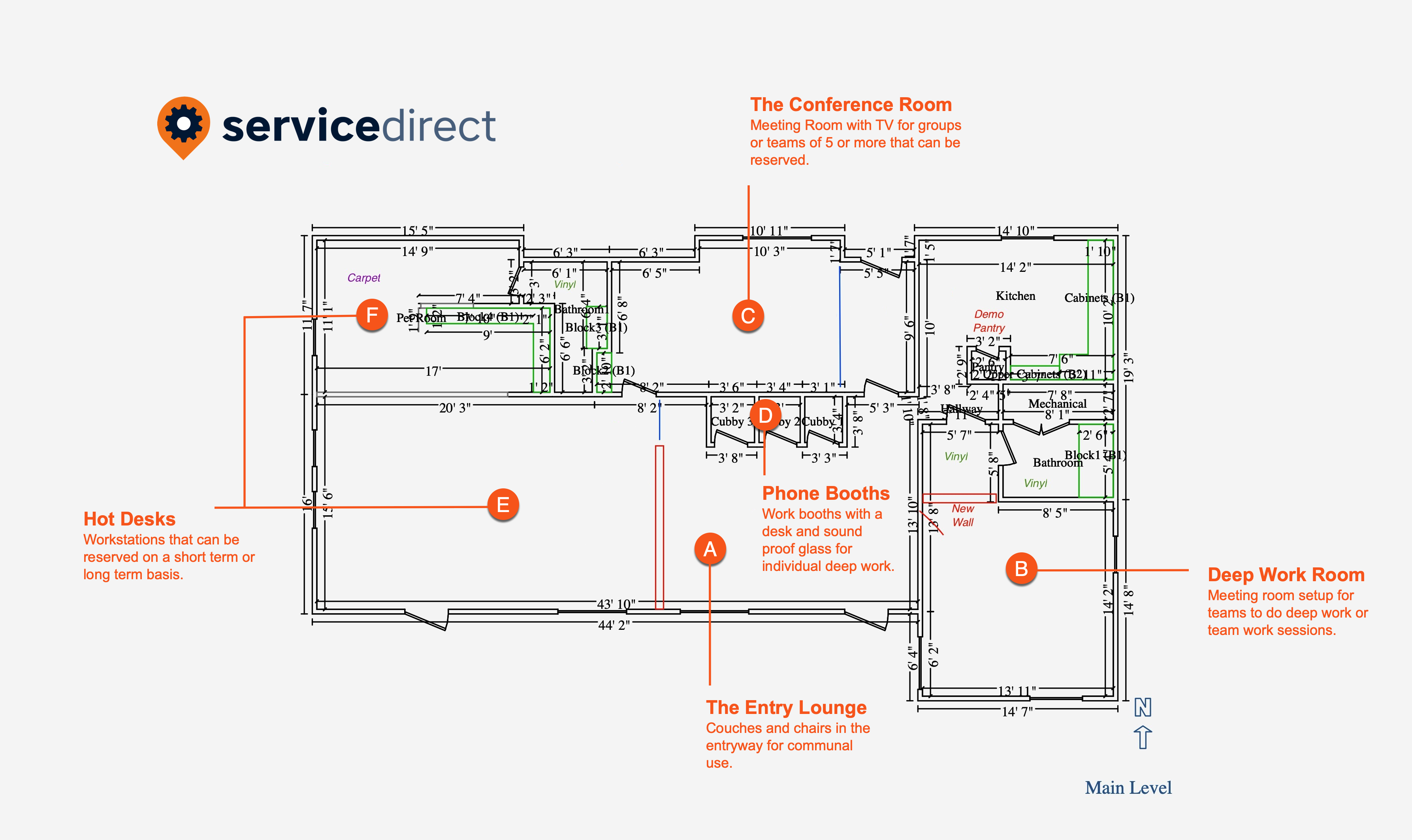
One of the most exciting parts about venturing into a hybrid workspace is that we can really get creative with how we use our office space. It’s not as simple as just filling the office with desks and saying “whoever wants them gets them.” We wanted to look at different models for how to effectively set up a hybrid office and take what we thought were the best bits and pieces of each concept. It was also important that we asked our employees what they would like to use the space for. That way, if most people wanted to use it for meetings for example, we could add more meeting spaces to ensure those needs are met. Keeping those things in mind has helped us develop what we believe will be the most useful, effective hybrid workspace.
For us that meant setting up single person “Hot Desks” that can be reserved either long or short term, having a dedicated chat room for people who spend most of their workday on the phone, establishing spacious and safe group meeting rooms, and incorporating deep work phone booths that are soundproof for people who need quiet. We are also extremely fortunate to work in the city of Austin where the weather is mild for a significant portion of the year. Our office has a garden with picnic tables so that people can safely meet outdoors and enjoy the weather while working.
Of course, we know that the transition to a hybrid office is likely not going to be smooth the whole way through, but we are confident that we will do everything we can to make it as easy as possible for our employees. Ultimately, we are just focusing on three things: communication, flexibility, and safety. With clear, consistent communication many of the roadblocks in the transition period could be avoided. Flexibility in figuring out what works best for everyone at the company will help us ensure all of our employees—no matter how much time they end up spending in the hybrid office—feel listened to and valued. The safety of every Service Direct employee and their families is paramount and by listening to the CDC, local governments, and our employees’ comfort level related to the Coronavirus pandemic we will do everything we can to continue prioritizing that safety.
When it comes down to the future of our office space as a hybrid office, one word sums it up: excited. We are excited to see what unique opportunities evolve from this new workplace model. We are excited to lead the way in providing a more appealing, flexible workplace for our employees. Most of all, we are so excited to have many people in the Service Direct family safely working together again very soon.

